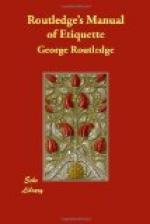Jewellery is another accessory. Jewels, real jewels, are in the possession of only a few. They are so costly that only millionaires or the heirs of heirlooms can have them. They are very beautiful, and have this one merit, that a few jewels, judiciously selected and worn, make a person well dressed at once. A diamond necklace and brooch, diamond earrings, and a few diamond stars glittering in the hair, will make almost a shabby dress pass muster at Court. But jewellery is a term that is applied to ornaments generally, and not to jewels only.
Sham jewellery is an abomination. It is a lie, and a pretension. At no time was so much sham jewellery made and worn. Every damsel has her brooches and her earrings. In nine cases out of ten they are mere trumpery, but, such as they are, no maid of all work will go out for her Sunday walk without her brooch and earrings and chain. She must have her locket too, fastened round her throat with black velvet, but it is all, with the exception of the velvet, a sham.
Ladies too have a weakness for sham jewellery. They will wear massive bracelets, cameo brooches of target dimensions, earrings, chains, all of what they pleasantly call French manufacture. It is called French in the shops in order to soften down its imposture, and to play upon the weakness of our country women who are apt to think that whatever is French must be good. But in many cases they are of Birmingham manufacture.
We enter our protest very strongly against the use of sham jewellery, though we must own without much hope of success, for, it must be admitted, that a great quantity of it is exceedingly pretty. We are not surprised that it should be popular, for who can resist the opportunity of making herself fine and “beautiful for ever” at the cost of a few shillings, which is all that is necessary to lay in a fair stock of jewellery.
This sham jewellery is continually mistaken for real, so good is the resemblance.
If a duchess were to wear it everyone would take for granted that it was real, because she would not be supposed to wear anything that is unreal. We have heard of a lady who, possessing but very few jewels, always makes up for the deficiency by wearing sham diamonds. They are good of their kind, and no one ever suspects them to be false, simply because there is no reason why she should not have real diamonds, but, on the contrary, so far as the world knows, every reason why she should.
In the use of jewellery more than in anything else we maintain that all persons should dress according to their station and their means. If they can afford it—let them—but we recommend them not to act too much upon the old saying, that “fine feathers make fine birds,” but to bear in mind that being well dressed means something more than well-fitting, well-selected clothes.
* * * * *
VI.—“A FEW WORDS MORE.”




